Fighting for every childhood: How the NSPCC’s award-winning charity intranet is supporting its mission
The UK’s leading children charity is using a social intranet to engage workers in achieving their organisational goals
As the UK’s leading and most recognised children’s charity, the NSPCC is driven by its vision: to end child abuse in the UK and Channel Islands.
With a diverse and geographically-dispersed workforce, the charity has a nationwide presence. With this reach comes several challenges for the organisation: particularly when it comes to connecting and communicating with its staff.
In April 2016, the NSPCC launched its new intranet, “The Green”, before going on to take the award for Best Intranet Launch at the Interact Excellence Awards in October. NSPCC Internal Communications Manager, Katie Hawkins, showcases how its launch of a social intranet helped engage workers and support the charity’s mission – to fight for every childhood.
The NSPCC – fighting for every childhood
We’re the leading children’s charity fighting to end child abuse in the UK and Channel Islands. We:
- help children who have been abused to rebuild their lives
- protect children at risk
- find the best ways of preventing abuse from ever happening
We have over 2,000 staff and 11,000 volunteers across the UK and Channel Islands. They have wide-ranging roles, spend varied amounts of time at desk/work and have different time pressures, so how they consume and digest information is diverse. Effective internal communications alongside a high-quality intranet is vital to engage and connect our workforce.
Land before The Green
NSPCC family
From our research, we knew that those outside of London, where our head office is based, could feel disengaged and isolated. Staff built local networks but struggled to widen or share them.
With a geographically dispersed staff group, a proportion of whom are home workers, we had some clear goals. It was important they felt connected to the organisation, could collaborate with one another, celebrate achievements, and had a voice.
We also needed to ensure our staff worked with a set of shared values and received consistent, joined-up messages that painted a seamless NSPCC story.
Leadership needed to be visible to instil trust and confidence in how the organisation is run. And we needed to reflect ‘one’ NSPCC so that we all, from our staff and volunteers to our corporate and service partners, work towards one common goal; keeping children safe.
Force of habit
When you have a message to communicate, it’s easy to send an email. Unfortunately, staff receive too many emails. Our research tells us that they don’t know what to prioritise and often don’t read them; some also get more time and opportunities to read their emails than others.
That’s not to mention those big attachments that strain the sides of your mailbox so you’re regularly receiving that dreaded message – ‘You’ve reached your mailbox limit’ – ironically sent in an email!
Given these challenges, it was important for our new intranet to help reduce the number of emails and attachments being sent, facilitate better two-way communication and host content that has a wide audience.
Farewell, old friend
We had our previous intranet, FirstStop, for 13 years. The content management system was dated and unsupported. It was clunky, old and in urgent need of a new brand overhaul. However, people had become accustomed to it and even grew fond of its quirky snags, using workarounds to get what they needed.
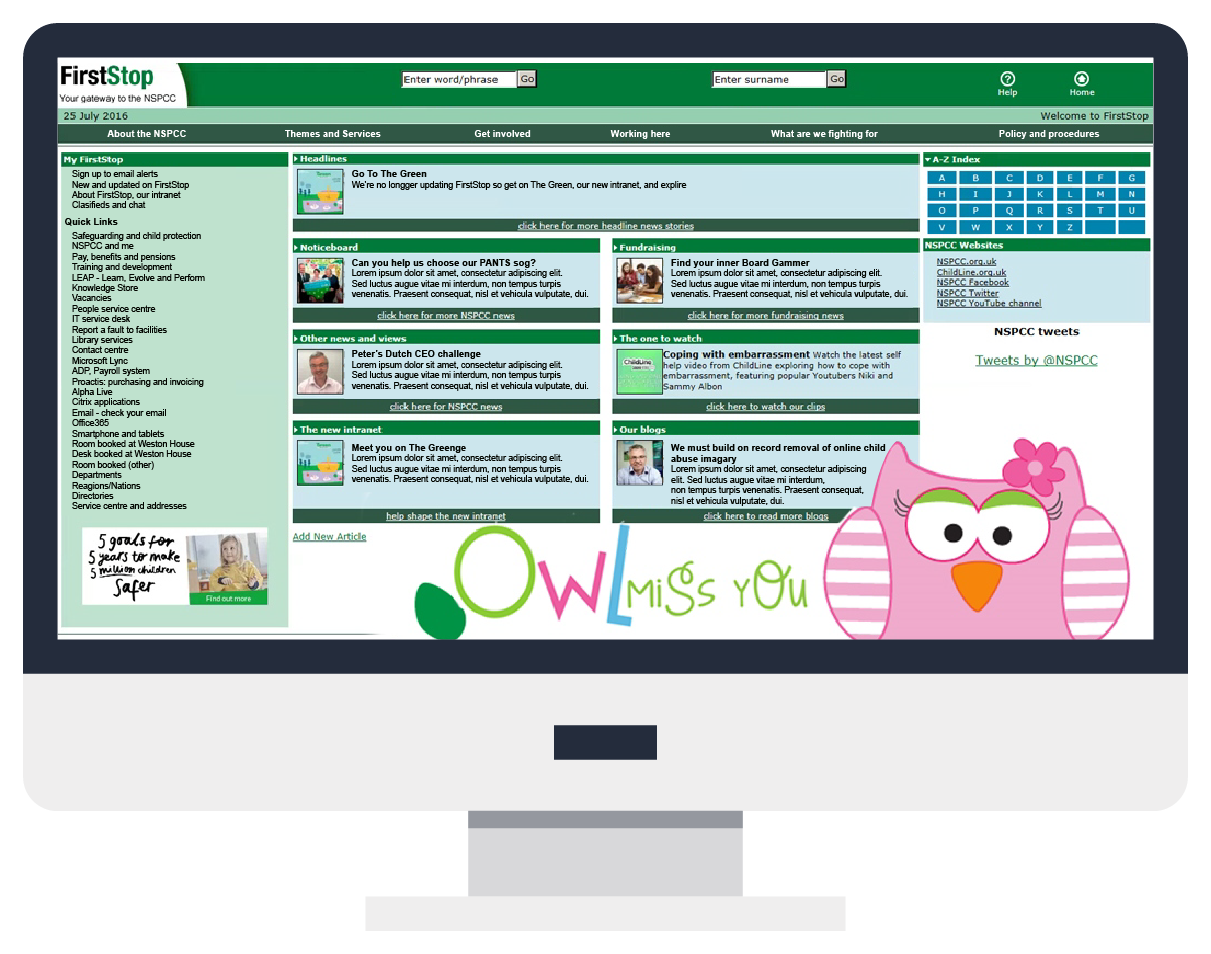
In our research staff told us what they thought of FirstStop:
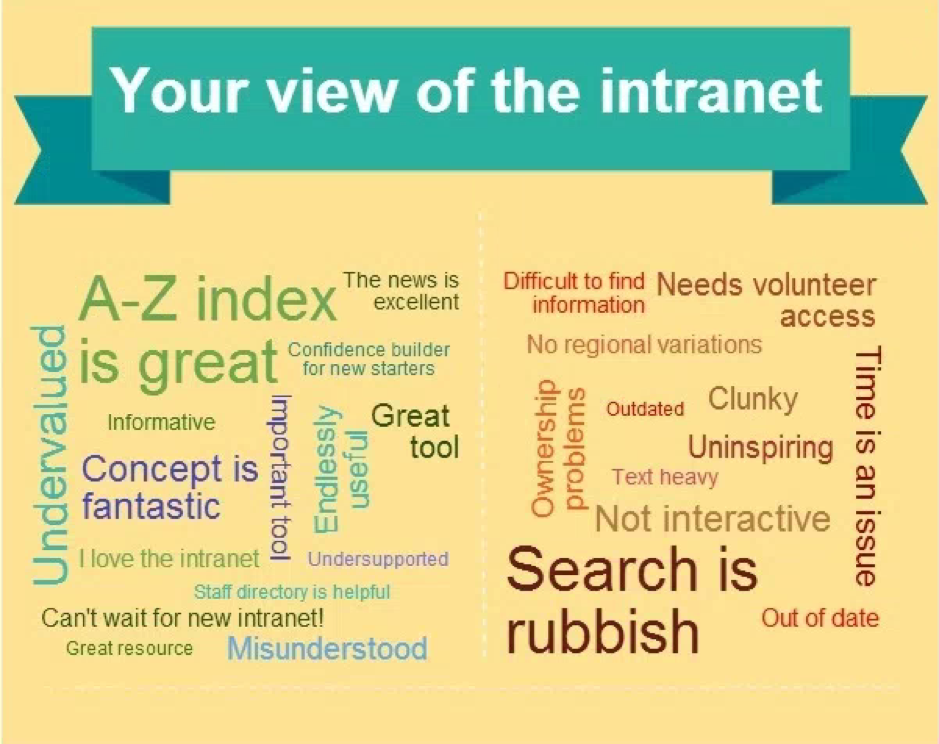
The need for an effective intranet was obvious.
But it was clear we needed to engage staff in the new intranet as early as possible to prevent the assumption that the new one would have the same user challenges or features, which could cause usage to drop. We wanted to ensure staff understood how the new intranet would help them fulfil their roles, which in turn would increase usage.
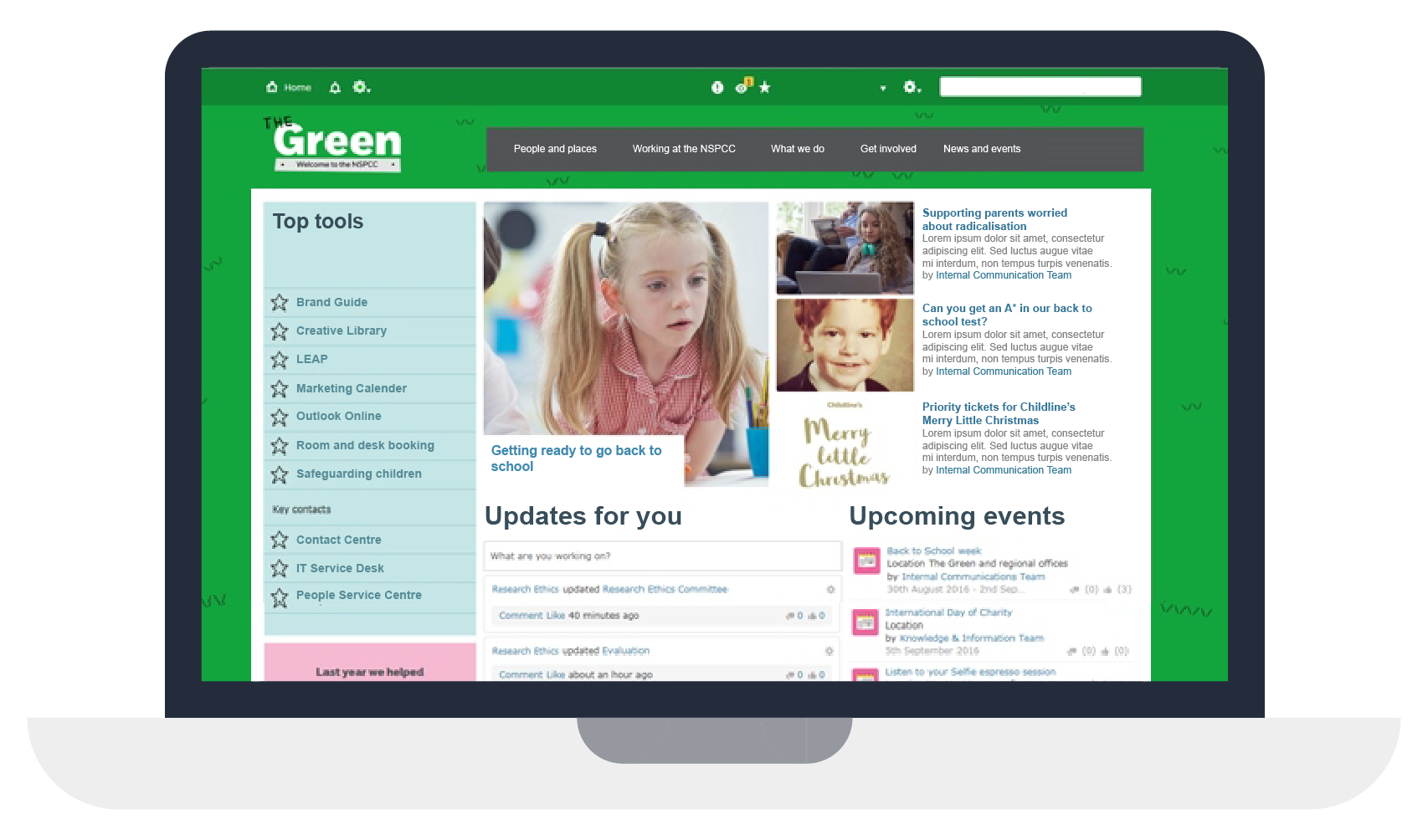
The Intranet Project team ran a robust research exercise for seven months, which Internal Communications was central to. Our objective was to understand what staff needed, using this to inform how we could engage them in the project. We carried out:
- Stakeholder workshops with all directorates
- 80 interviews and 24 diary studies
- User surveys
- Visits to other organisations
- Attendance at intranet conferences and networking events
- Content workshops
- Card sorting workshops
We gathered and analysed common behaviours and opinions, identifying what users come to the intranet to do. From this, we could specify what our key user needs were:
- To find what they want, when they want it, wherever they are
- To be confident that information is accurate, up-to-date and comprehensive
- To know what the organisation does and is planning to do
- To make connections and work collaboratively
- To get employment and work tasks done
To achieve this, we needed to make sure our intranet was built around these objectives:
- One NSPCC – promote organisational culture and reflect ‘one’ NSPCC
- Share and inspire – share stories, inspire and engage, celebrate success and demonstrate impact
- Collaboration – encourage and facilitate learning, communication and collaboration
- Build knowledge – ensure we don’t lose knowledge when people leave
- Support staff and volunteers – help them to do their jobs
- Improve business efficiency – streamline processes wherever possible and reduce costs
We also established a core aim:
Everyone should leave our intranet better equipped to play their part in fighting for every childhood.
The intranet was then designed and built, and we were ready to launch.
However, as a charity, our budget for launching The Green was limited. We had to use our resources as best we could to engage staff, including utilising staff themselves.
Pre-launch
Staff played an important role in the research and this engaged them from the get-go. They were given lots of opportunities to share their voice and they understood that they were helping us to develop an intranet that was effective for them.
We involved all types of staff, from homeworkers and mobile users to colleagues delivering frontline services and those based in the Channel Islands. We also had an intranet project group with representatives from all directorates who fed back comments and ideas from their peers.
Alongside this, we also:
- Ran a competition to name the intranet, with the winner receiving a small gift one of our supporters had donated. We whittled the names down to the top five and asked staff to vote for their favourite. Nearly 600 staff voted and the name that was chosen was The Green.
- Created a pod on the existing intranet homepage just for updates or stories about the new intranet – this helped us to make sure it was always front of mind.
- Published stories asking staff to test and feedback on proposed navigation.
- Published a story near to launch giving staff the opportunity to see it being built in stages – they were able to leave comments.
- Asked staff who are budding photographers to send in pictures of what the NSPCC meant to them for a grand unveil on the new intranet.
- Encouraged our Communications directorate (nearly 100 staff) to lead the way on The Green by holding sessions on getting to know the new intranet during an internal learning week event.
- Ensured transparency throughout the project and had a project page, which we regularly updated and used to publish all our research.
- Contacted existing intranet authors about the decommissioning of FirstStop and spoke to heads of departments to agree who should be authors of the new intranet.
- Sent regular information to those who would continue to be authors about new content strategy and standards, alongside where their content would be.
In the six weeks before launch, we ran a teaser poster campaign across all our offices. The focus was on the key benefits for staff; they also played on the name by using a style that reflected a village green, a community. Every two weeks, we worked with staff at each base to change these posters to a different one.
Roll-out
We worked closely with IT to make sure The Green was the new web browser homepage for all desktop and mobile devices from the launch date.
On launch day, we:
- Sent out a bespoke designed email from our chief executive to all staff at 8am directing staff to The Green. Not only did endorsement from the chief executive give it gravitas, but so did the framing of it as a tool to help us achieve our newly launched corporate strategy. The click through rate was 51% (nearly 20% more than industry average).
- Developed a video which we embedded in the email, introduced by our chief executive, with colleagues from across the organisation showcasing how they use the new intranet to help them in their role. The video used stop motion, utilising princess and bear toys to link it back to the work we do for children. These toys represent our play therapy service, Letting the Future In, which helps children recover from sexual abuse.
- Published a story on the intranet homepage, welcoming staff to The Green and providing an overview of all the key functionality. This included lots of hints and tips, and featured the video.
- Put up the final poster across all offices and kept it up for six weeks.
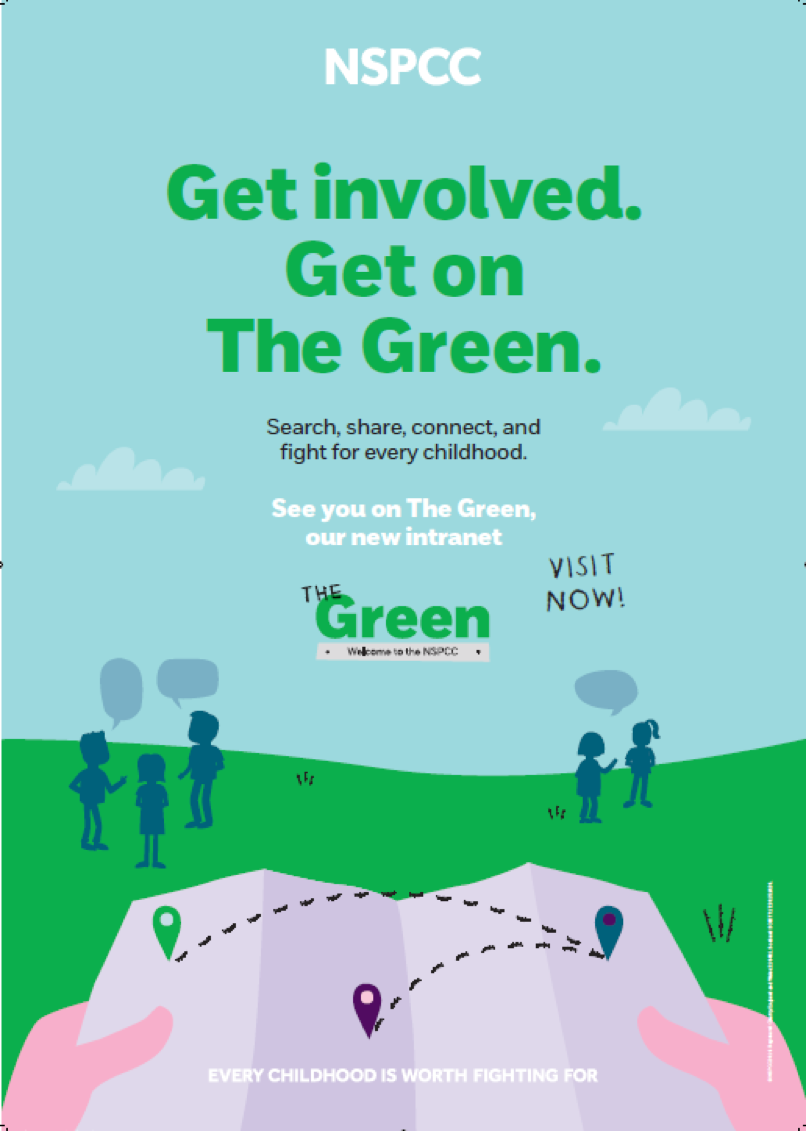
The image below was displayed on a large screen in the reception of our London office, inspiring staff to use The Green every time they walked into the building.
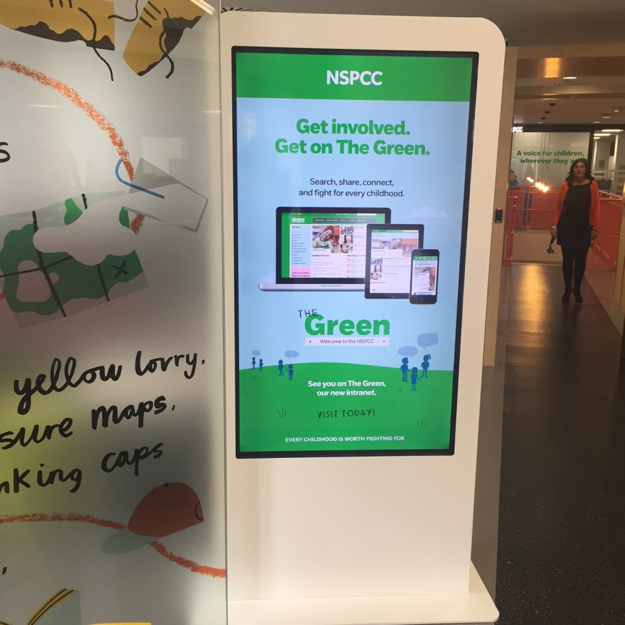
During launch week, we also:
- Facilitated director emails tailored to each directorate, with key messages relevant to them. This leadership-led endorsement highlighted the intranet’s importance.
- Sent a tailored email to managers with the top five things about the intranet to tell their team.
- Set up a discussion group on The Green for staff to give us their feedback and suggestions.
- Worked with directors to set up blogs under their profiles on The Green – most blog weekly, helping to increase their visibility.
Life with The Green
Post-launch
Since launch, we’ve had on average c75,000 visits a month, looking at c220,000 pages. We now have over 80 bloggers, over 500 likes on different content and 26 forums.
The Green connects staff wherever they are and whatever role they are in. This has been demonstrated by the rise in engagement levels in and outside of London in terms of comments, likes and forum involvement. The number of emails being sent across the organisation has decreased, with a lot of messages now shared on The Green.
We’ve continued to build staff interaction with The Green by:
- Publishing news stories on the homepage every day (the highest read story had nearly 1,000 unique page views in one day)
- Utilising the comment section of pages to provide regular updates throughout the day on particular news, such as live posts from an NSPCC conference or for an ongoing IT issue
- Encouraging staff to blog their message instead of a news story if it is more apt, eg to celebrate a piece of work (there were nearly 150 blog posts in three months). We share blogs with staff for whom the topic might be of interest, providing them with the opportunity to comment
- Encouraging leadership to use it – directors actively compete for followers, post updates and blogs, comment on pages/stories and celebrate achievements
- Linking to pages on The Green in a weekly newsletter to read more, which also features ‘top blog’ and ‘new on The Green’ pods
- Transferring regular email updates/news that teams send across the organisation onto The Green
- Meeting with different groups of staff to show them how they can make the most out of The Green, including for example our group for deaf and disabled workers
- Utilising the ‘mandatory read‘ functionality to ask staff to complete information security training, which was marked as read and understood by over 1,100 staff. Lots of staff were also commenting on the page about the duration of the course, including our chief executive
- Promoting different functionality on the intranet every two weeks to educate staff on the new elements and inspire them to use it, such as updating profiles and writing blogs.
Key examples
For Volunteers’ Week in June we set up a forum for staff to leave their messages of thanks for our volunteers. We received nearly 40 messages which we shared with volunteers.
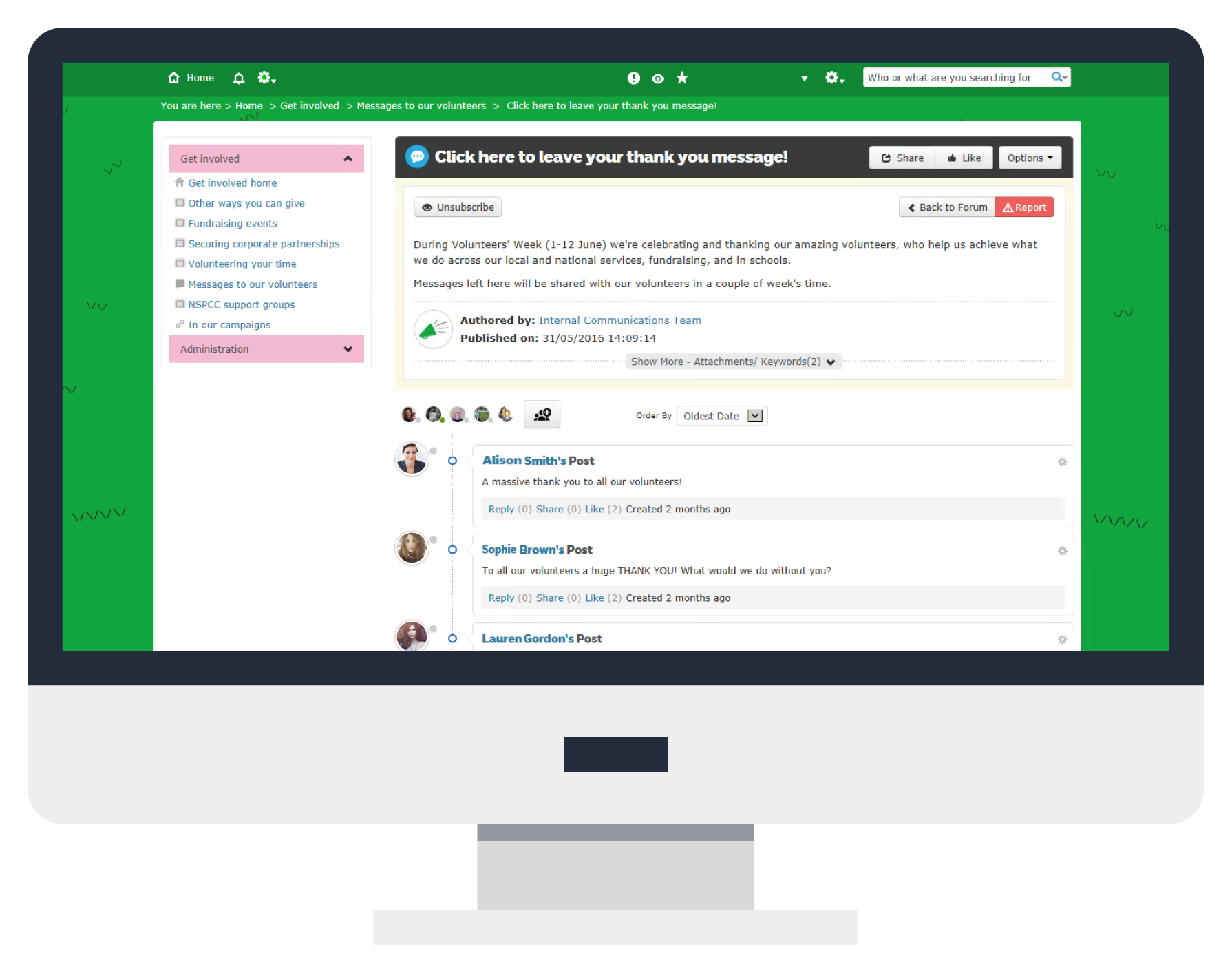
One of our copywriters publishes a ‘Word-nesday’ of the week every Wednesday and is regularly commented on and liked – has had over 2,500 hits (at 7 December 2016).
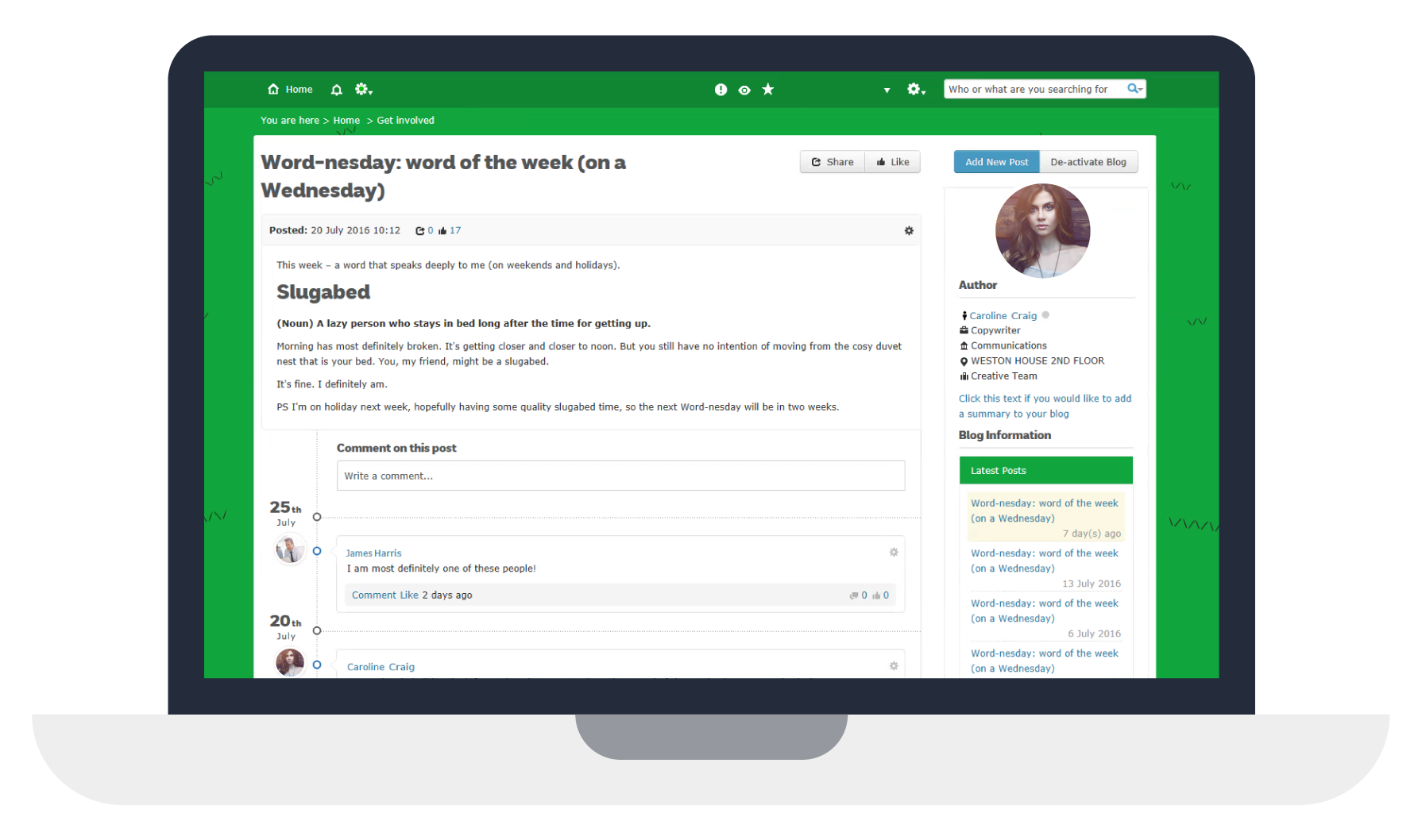
Live updates from our annual How safe are our children? conference – had nearly 700 unique page views:

Our new PANTS campaign story received nearly 900 unique page views and 18 comments, giving staff who aren’t based at the same location as the project team of PANTS the opportunity to ask questions they might not have been able to ask before The Green.
Since the launch, staff have told us:
“It’s really easy to use – very intuitive – so it’s easy to find people, recent NSPCC news and useful bits and bobs for my work. I feel more connected to what other people are doing across the NSPCC as a result.”
“The Green has given individuals a platform to share their views and connect with others. Content is now far more engaging and dynamic, mirroring aspects of social media sites which instantly creates a sense of familiarity.”
“The Green has been a great addition to internal comms at the NSPCC – it’s interactive and engaging, and has made it so much easier to find and share information about work.”
“The Green is such a useful tool, in my role I need to be able to access information quickly and efficiently and having everything is one please and being able to easily search for what I need makes my job a lot easier. Having a home page ‘dashboard’ is also very handy as all useful links and news items are there waiting for me to look at to keep me up to date and on the ball with internal and external information.”
“It brings everything together in a clear and easy-to-navigate way. It makes my job easier by allowing me to find stats, news and other resources instantly; and also means we can promote new campaigns and let other teams know everything we’re working on.”
“As a person who is terrible at remembering faces, The Green is incredibly useful! Fairly often I have meetings with someone internal who I’ve never met before and it’s invaluable to be able to find out what they look like, where they sit and what team they’re in.
“I also really like getting feedback – both the positive and the challenges – from other teams and offices when new campaigns launch. It also really helps having all the current blogs and announcements in one place, which saves a good amount of time spent searching through old emails.”
“The Green is an amazing source of news stories, updates and helping processes to become easier. Love it :-).”
In their case study video, representatives from the NSPCC talk about the drivers for their new intranet project and the subsequent gains seen as a result of implementing The Green, which now forms a cornerstone piece of their internal digital communications strategy.
